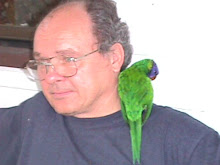DECIDEDLY DECEMBER
December was going to be a month
of two halves.
Up to and including Friday 13th
birding was to be decidedly patchy in birding terms; final report cards to
compose – how do you tell a doting mother that her beloved daughter is
decidedly a sandwich short of a full picnic, or, how do you find a way of
pointing out to the obviously unwashed father whose every other utterance is a
four-lettered expletive that he can’t really hold the school responsible for
the decidedly foul language used by his macho 9-year old son? Not that it’s all that way inclined; for the
vast majority it’s just finding another way of repeating more or less what you
maintained at the end of the first semester.
Leopards and spots?
From Saturday 14 December it was
to be a decidedly more birdy period. I
was effectively retired after 43 years in teaching. Summer vacation and long-service leave would
keep me out of the classroom until my actual retirement on 25 April 2014. My time was my own and birding was decidedly
on the horizon.
On the other hand - and no doubt
Papa Hemmingway would have penned it in a far more appropriate style, something
about the best laid plans of mice and men- there was always the unexpected; the
long list of chores that had somehow slipped below my radar while my head was
buried in schoolbooks and report cards: the verandahs needed ceilings; the
bannister rails needed repairing and painting; the henhouse leaked; there was a
carpet snake housed under the pigeon loft; there was weeding to be done and
holes to be dug for new plants and of course the house needed cleaning up in
preparation for Christmas. Did I mention
Christmas cards to write and post and presents to be wrapped?
It wasn’t the lowest December on
record [46 in 2002] but it was decidedly not among the best and fell ten [10]
short of the 70 species tallied in December 2011. At 60 species it equalled the 2009 tally; in
6th place over thirteen [13] years of records.
The three regularly nocturnal
raptors maintained their presence: White-throated Nightjar Eurostopodus
mystacalis [1st, 2nd and 24th];
Southern Boobook Ninox boobook
[1st and 7th] and the Tawny Frogmouth Podargus trigoides [5th,
14th and 15th].
The cuckoos also put in a
reasonable showing with the Brush Cuckoo Cacomantis variolosus [26th,
28th and 29th] making the largest contribution. The Fan-tailed Cuckoo Cacomantis flabelliformis and Little
Bronze-Cuckoo Chrysococcyx minutillus
both showed on 7th December. The
Red-winged Parrot Aprosmictus
erythropterus made a solitary appearance on 4th December.
That left the month’s limelight
to the Black-Cockatoos. The Yellow-tailed
Black-Cockatoo Calyptorhynchus
funereus [16th, 17th, 18th and 19th]
and the darlings of our Backyard Birds, the Glossy Black-Cockatoo Calyptorhynchus
lathami [14th,
16th, 28th and 29th], put in some decidedly
spectacular appearances, seeming to time their arrival as Fay and I sat on the verandah
sipping a glass or two of Australia’s decidedly finest reds.



No comments:
Post a Comment